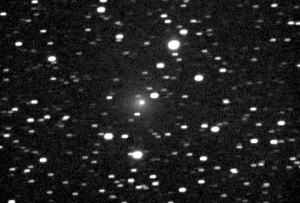
4015 Wilson–Harrington is an active asteroid known both as comet 107P/Wilson–Harrington and as asteroid 4015 Wilson–Harrington. It passed 0.4 AU (60 million km) from Earth on 20 July 2022 and then passed perihelion on 24 August 2022. It seldom gets brighter than apparent magnitude 16. It will return to perihelion on 25 November 2026.

Comet Arend–Roland was discovered on November 8, 1956, by Belgian astronomers Sylvain Arend and Georges Roland on photographic plates. As the eighth comet found in 1956, it was named Arend–Roland 1956h after its discoverers. Because it was the third comet to pass through perihelion during 1957, it was then renamed 1957 III. Finally, it received the standard IAU designation C/1956 R1 (Arend–Roland), with the "C/" indicating that it was a non-periodic comet and the "R1" showing that it was the first comet reported as discovered in the half-month designated by "R". The last is equivalent to the period September 1–15.

Comet 4P/Faye is a periodic Jupiter-family comet discovered in November 1843 by Hervé Faye at the Royal Observatory in Paris. Its most recent perihelia were on November 15, 2006; May 29, 2014; and September 8, 2021.
56P/Slaughter–Burnham is a periodic comet in the Solar System with a period of 11.54 years.

65P/Gunn is a periodic comet in the Solar System which has a current orbital period of 6.79 years. The comet is a short-period comet, orbiting the Sun every 6.79 years inside the main asteroid belt between the orbits of the planets Mars and Jupiter.

71P/Clark is a periodic comet in the Solar System with an orbital period of 5.5 years.

77P/Longmore is a periodic comet in the Solar System, with a period of 6.8 years.

78P/Gehrels, also known as Gehrels 2, is a Jupiter-family periodic comet in the Solar System with a current orbital period of 7.22 years.

Comet Schaumasse is a periodic comet discovered by Alexandre Schaumasse on 1 December 1911 as 12th magnitude. It next comes to perihelion on 8 January 2026 and should brighten to about magnitude 9.
Comet Taylor, is a periodic comet in the Solar System, first discovered by Clement J. Taylor on November 24, 1915.
35P/Herschel–Rigollet is a periodic comet with an orbital period of 155 years and an orbital inclination of 64 degrees. It fits the classical definition of a Halley-type comet with. It was discovered by Caroline Herschel on 21 December 1788. Given that the comet has a 155-year orbit involving asymmetric outgassing, and astrometric observations in 1939 were not as precise as modern observations, predictions for the next perihelion passage in 2092 vary by about a month.

68P/Klemola or Klemola's Comet is a periodic comet, which belongs to Jupiter's comet family, that was discovered in 1965 by American astronomer Arnold Richard Klemola in Argentinian Yale-Columbia Southern Station. Its orbital period is 10.82 years.
255P/Levy, formerly P/2006 T1 and P/2011 Y1, is a periodic comet with an orbital period of 5.25 years. It last came to perihelion on 14 January 2012. During the 2006 passage the comet achieved an apparent magnitude of ~9.5. Levy (PK06T010) was believed to have been recovered on 3 June 2011 at magnitude 19.8, but other observatories were unable to confirm a recovery. It was most likely a false positive because of large residuals. Levy was recovered on 17 December 2011 at magnitude 19.8, and given the second designation 2011 Y1. It was then numbered.

62P/Tsuchinshan, also known as Tsuchinshan 1, is a periodic comet first discovered January 1, 1965 at the Purple Mountain Observatory in Nanking. It last came to perihelion on 25 December 2023 at around apparent magnitude 8, and was then 0.53 AU (79 million km) from Earth and 110 degrees from the Sun.
51P/Harrington is a periodic comet in the Solar System.

115P/Maury, is a periodic Jupiter-family comet, discovered on August 16, 1985, from the Palomar Observatory by Alain Maury. When the comet was first announced on 1985 September 6, the confirmation came quickly from other observers located at the Palomar Observatory. To the initial announcement of the comet, several confirmations were announced in multiple different reports were compiled by S. Singer-Brewster, D. Schneeberger, and M. Gallup that found the 15th-magnitude trail of the comet on a plate exposed with the 0.46-m Schmidt telescope. These came from the staff at Palomar Observatory, who used the 1.5-m reflector and a CCD to detect the comet. The comet was continued to be followed and detected, leading to Scientist giving the comet a 8.6 to 8.8 orbital period.
83D/Russell is a periodic lost comet in the Solar System with an orbital period of about 7.5 years. On the post-1988 orbit the comet probably does not get brighter than about apparent magnitude 21. The comet might come to perihelion in late May 2021, but the uncertainty in the comet's position is a few million km.

76P/West–Kohoutek–Ikemura is a Jupiter-family periodic comet in the Solar System with a current orbital period of 6.48 years.

126P/IRAS is a periodic comet with an orbital period of 13.4 years. It was discovered in images taken by the Infrared Astronomical Satellite (IRAS) on 28 July 1983 by J. Davies. The discovery was confirmed with images taken with the 1.2-m Schmidt telescope at Palomar Observatory.

156P/Russell–LINEAR is a Jupiter family periodic comet with an orbital period of 6.4 years. It was discovered by Kenneth S. Russell in September 1986.
















